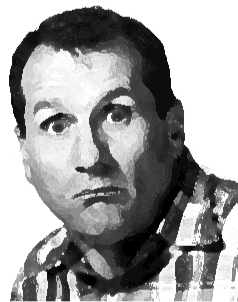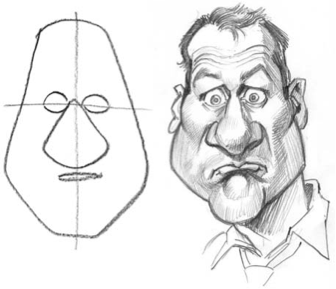What’s the essential skill of a cartoonist? Drawing ability? Humor? A deep well of childhood trauma?
I’d say it’s an eye for simplification, capturing the essence of an idea.
For example, let’s say we want to understand Ed O’Neill:

A literal-minded artist might portray him like this:

While the technical skill is impressive, does it really capture the essence of the man? Look at his eyes in particular.

Wow! The cartoonist recognizes:
The unique shape of his head. Technically, his head is an oval, like yours. But somehow, making his jaw wider than the rest of his head is perfect.
The wide-eyed bewilderment. The whites of his eyes, the raised brows, the pursed lips – the cartoonist saw and amplified the emotion inside.
So, who really “gets it”? It seems the technical artist worries more about the shading of his eyes than the message they contain.
Numbers Began With Cartoons
Think about the first numbers, the tally system:
I, II, III, IIII …
Those are… drawings! Cartoons! Caricatures of an idea!
They capture the essence of “existing” or “having something” without the specifics of what it represents.
Og the Cavemen Accountant might have tried drawing individual stick figures, buffalos, trees, and so on. Eventually he might realize a shortcut: draw a line and call it a buffalo. This captures the essence of “something is there” and our imaginations do the rest.
Math is an ongoing process of simplifying ideas to their cartoon essence. Even the beloved equals sign (=) started as a drawing of two identical lines, and now we can write “3 + 5 = 8” instead of “three plus five is equal to eight”. Much better, right?
So let’s be cartoonists, seeing an idea — really capturing it — without getting trapped in technical mimicry. Perfect reproductions come in after we’ve seen the essence.
Technically Correct: The Worst Kind Of Correct
We agree that multiplication makes things bigger, right?
Ok. Pick your favorite number. Now, multiply it by a random number. What happens?
- If that random number is negative, your number goes negative
- If that random number is between 0 and 1, your number is destroyed or gets smaller
- If that random number is greater than 1, your number will get larger
Hrm. It seems multiplication is more likely to reduce a number. Maybe we should teach kids “Multiplication generally reduces the original number.” It’ll save them from making mistakes later.
No! It’s a technically correct and real-life-ily horrible way to teach, and will confuse them more. If the technically correct behavior of multiplication is misleading, can you imagine what happens when we study the formal definitions of more advanced math?
There’s a fear that without every detail up front, people get the wrong impression. I’d argue people get the wrong impression because you provide every detail up front.
As George Box wrote, “All models are wrong, but some are useful.”
A knowingly-limited understanding (“Multiplication makes things bigger”) is the foothold to reach a more nuanced understanding. (“People generally multiply positive numbers greater than 1, so multiplication makes things larger. Let’s practice. Later, we’ll explore what happens if numbers are negative, or less than one.”)
Takeaways
I wrap my head around math concepts by reducing them to their simplified essence:
Imaginary numbers let us rotate numbers. Don’t start by defining i as the square root of -1. Show how if negative numbers represent a 180-degree rotation, imaginary numbers represent a 90-degree one.
The number e is a little machine that grows as fast as it can. Don’t start with some arcane technical definition based on limits. Show what happens when we compound interest with increasing frequency.
The Pythagorean Theorem explains how all shapes behave (not just triangles). Don’t whip out a geometric proof specific to triangles. See what circles, squares, and triangles have in common, and show that the idea works for any shape.
Euler’s Formula makes a circular path. Don’t start by analyzing sine and cosine. See how exponents and imaginary numbers create “continuous rotation”, i.e. a circle.
Avoid the trap of the guilty expert, pushed to describe every detail with photorealism. Be the cartoonist who seeks the exaggerated, oversimplified, and yet accurate truth of the idea.
Happy math.
PS. Here’s my cheatsheet full of “cartoonified” descriptions of math ideas.
Other Posts In This Series
- Developing Your Intuition For Math
- Why Do We Learn Math?
- How to Develop a Mindset for Math
- Learning math? Think like a cartoonist.
- Math As Language: Understanding the Equals Sign
- Avoiding The Adjective Fallacy
- Finding Unity in the Math Wars
- Brevity Is Beautiful
- Learn Difficult Concepts with the ADEPT Method
- Intuition, Details and the Bow/Arrow Metaphor
- Learning To Learn: Intuition Isn't Optional
- Learning To Learn: Embrace Analogies
- Learning To Learn: Pencil, Then Ink
- Learning to Learn: Math Abstraction
- Learning Tip: Fix the Limiting Factor
- Honest and Realistic Guides for Learning
- Empathy-Driven Mathematics
- Studying a Course (Machine Learning) with the ADEPT Method
- Math and Analogies
- Colorized Math Equations
- Analogy: Math and Cooking
- Learning Math (Mega Man vs. Tetris)